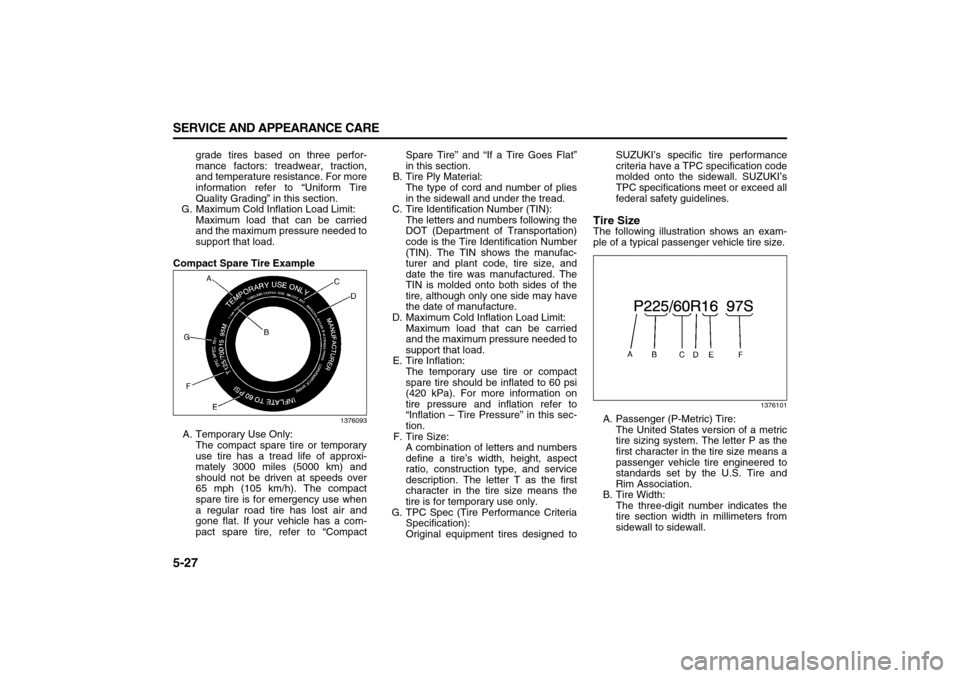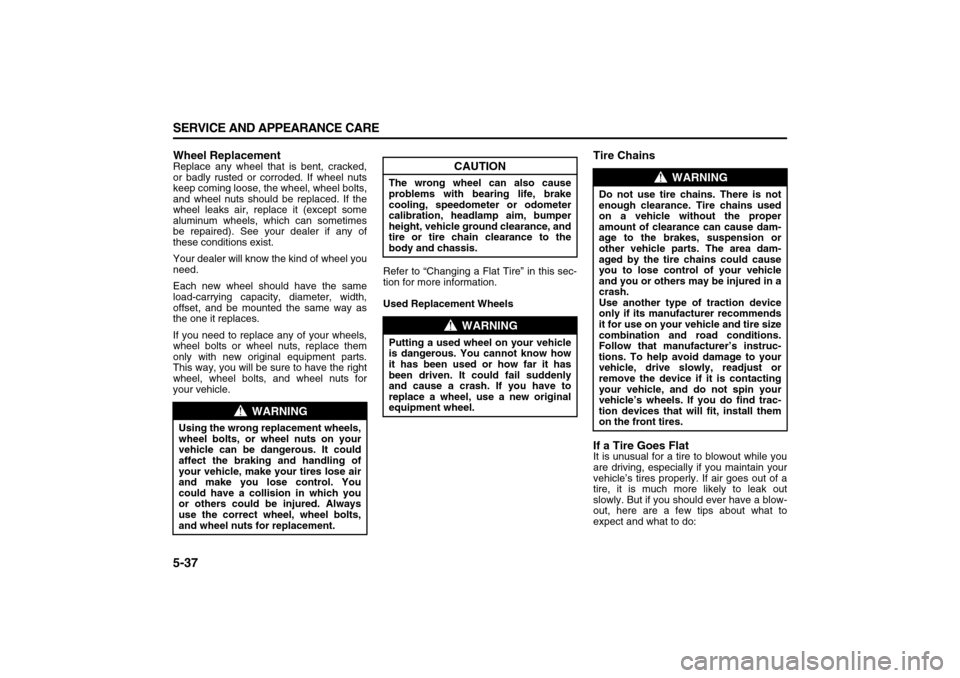Traction SUZUKI XL7 2007 2.G Owner's Manual
[x] Cancel search | Manufacturer: SUZUKI, Model Year: 2007, Model line: XL7, Model: SUZUKI XL7 2007 2.GPages: 274, PDF Size: 6.12 MB
Page 185 of 274

5-1 SERVICE AND APPEARANCE CARE
78J00-03E
ServiceYour dealer knows your vehicle best and
wants you to be happy with it. We hope
you will go to your dealer for all your ser-
vice and parts needs.Accessories and ModificationsWhen you add non-Suzuki accessories to
your vehicle they can affect your vehicle’s
performance and safety, including such
things as, airbags, braking, stability, ride
and handling, emissions systems, aerody-
namics, durability, and electronic systems
like anti-lock brakes, traction control, and
stability control. Some of these accesso-
ries may even cause malfunction or dam-
age not covered by warranty.
Suzuki accessories are designed to com-
plement and function with other systems
on your vehicle. Your Suzuki dealer can
accessorize your vehicle using genuine
Suzuki accessories. When you go to your
Suzuki dealer and ask for Suzuki accesso-
ries, you will know that Suzuki-trained and
supported service technicians will perform
the work using genuine Suzuki accesso-
ries.
California Proposition 65 WarningMost motor vehicles, including this one,
contain and/or emit chemicals known to
the State of California to cause cancer and
birth defects or other reproductive harm.
Engine exhaust, many parts and systems
(including some inside the vehicle), many
fluids, and some component wear by-prod-
ucts contain and/or emit these chemicals.Doing Your Own Service WorkIf you want to do some of your own service
work, you will want to use the proper ser-
vice manual. It tells you much more about
how to service your vehicle than this man-
ual can.Your vehicle has an airbag system. Before
attempting to do your own service work,
refer to “Servicing Your Airbag-Equipped
Vehicle” in “Airbag System” in the “Seats
and Restraint Systems” section.
You should keep a record with all parts
receipts and list the mileage and the date
of any service work you perform. Refer to
“Maintenance Record” in “Maintenance
Schedule” in the “Maintenance Schedule”
section.
Adding Equipment to the Outside of
Your VehicleThings you might add to the outside of
your vehicle can affect the airflow around
it. This may cause wind noise and affect
windshield washer performance. Check
with your dealer before adding equipment
to the outside of your vehicle.
WARNING
You can be injured and your vehicle
could be damaged if you try to do
service work on a vehicle without
knowing enough about it.
Be sure you have sufficient knowl-
edge, experience, the proper
replacement parts, and tools before
you attempt any vehicle mainte-
nance task.
Be sure to use the proper nuts,
bolts, and other fasteners. English
and metric fasteners can be easily
confused. If you use the wrong fas-
teners, parts can later break or fall
off. You could be hurt.
Page 211 of 274

5-27 SERVICE AND APPEARANCE CARE
78J00-03E
grade tires based on three perfor-
mance factors: treadwear, traction,
and temperature resistance. For more
information refer to “Uniform Tire
Quality Grading” in this section.
G. Maximum Cold Inflation Load Limit:
Maximum load that can be carried
and the maximum pressure needed to
support that load.
Compact Spare Tire Example
1376093
A. Temporary Use Only:
The compact spare tire or temporary
use tire has a tread life of approxi-
mately 3000 miles (5000 km) and
should not be driven at speeds over
65 mph (105 km/h). The compact
spare tire is for emergency use when
a regular road tire has lost air and
gone flat. If your vehicle has a com-
pact spare tire, refer to “CompactSpare Tire” and “If a Tire Goes Flat”
in this section.
B. Tire Ply Material:
The type of cord and number of plies
in the sidewall and under the tread.
C. Tire Identification Number (TIN):
The letters and numbers following the
DOT (Department of Transportation)
code is the Tire Identification Number
(TIN). The TIN shows the manufac-
turer and plant code, tire size, and
date the tire was manufactured. The
TIN is molded onto both sides of the
tire, although only one side may have
the date of manufacture.
D. Maximum Cold Inflation Load Limit:
Maximum load that can be carried
and the maximum pressure needed to
support that load.
E. Tire Inflation:
The temporary use tire or compact
spare tire should be inflated to 60 psi
(420 kPa). For more information on
tire pressure and inflation refer to
“Inflation – Tire Pressure” in this sec-
tion.
F. Tire Size:
A combination of letters and numbers
define a tire’s width, height, aspect
ratio, construction type, and service
description. The letter T as the first
character in the tire size means the
tire is for temporary use only.
G. TPC Spec (Tire Performance Criteria
Specification):
Original equipment tires designed toSUZUKI’s specific tire performance
criteria have a TPC specification code
molded onto the sidewall. SUZUKI’s
TPC specifications meet or exceed all
federal safety guidelines.
Tire SizeThe following illustration shows an exam-
ple of a typical passenger vehicle tire size.
1376101
A. Passenger (P-Metric) Tire:
The United States version of a metric
tire sizing system. The letter P as the
first character in the tire size means a
passenger vehicle tire engineered to
standards set by the U.S. Tire and
Rim Association.
B. Tire Width:
The three-digit number indicates the
tire section width in millimeters from
sidewall to sidewall.
Page 213 of 274

5-29 SERVICE AND APPEARANCE CARE
78J00-03E
Driving, the Road, and Your Vehicle” in the
“Driving Your Vehicle” section.
Intended Outboard Sidewall:
The side of an asymmetrical tire, that must
always face outward when mounted on a
vehicle.
Kilopascal (kPa):
The metric unit for air pressure.
Light Truck (LT-Metric) Tire:
A tire used on light duty trucks and some
multipurpose passenger vehicles.
Load Index:
An assigned number ranging from 1 to 279
that corresponds to the load carrying
capacity of a tire.
Maximum Inflation Pressure:
The maximum air pressure to which a cold
tire may be inflated. The maximum air
pressure is molded onto the sidewall.
Maximum Load Rating:
The load rating for a tire at the maximum
permissible inflation pressure for that tire.
Maximum Loaded Vehicle Weight:
The sum of curb weight, accessory weight,
vehicle capacity weight, and production
options weight.
Normal Occupant Weight:
The number of occupants a vehicle is
designed to seat multiplied by 150 lbs (68
kg). Refer to “Loading Your Vehicle” in
“Your Driving, the Road, and Your Vehicle”
in the “Driving Your Vehicle” section.Occupant Distribution:
Designated seating positions.
Outward Facing Sidewall:
The side of an asymmetrical tire that has a
particular side that faces outward when
mounted on a vehicle. The side of the tire
that contains a whitewall, bears white let-
tering, or bears manufacturer, brand, and/
or model name molding that is higher or
deeper than the same moldings on the
other sidewall of the tire.
Passenger (P-Metric) Tire:
A tire used on passenger cars and some
light duty trucks and multipurpose vehicles.
Recommended Inflation Pressure:
Vehicle manufacturer’s recommended tire
inflation pressure as shown on the tire
placard. Refer to “Inflation – Tire Pressure”
in this section and “Loading Your Vehicle”
in “Your Driving, the Road, and Your Vehi-
cle” in the “Driving Your Vehicle” section.
Radial Ply Tire:
A pneumatic tire in which the ply cords that
extend to the beads are laid at 90 degrees
to the centerline of the tread.
Rim:
A metal support for a tire and upon which
the tire beads are seated.
Sidewall:
The portion of a tire between the tread and
the bead.Speed Rating:
An alphanumeric code assigned to a tire
indicating the maximum speed at which a
tire can operate.
Traction:
The friction between the tire and the road
surface. The amount of grip provided.
Tread:
The portion of a tire that comes into con-
tact with the road.
Treadwear Indicators:
Narrow bands, sometimes called wear
bars, that show across the tread of a tire
when only 1/16 inch (1.6 mm) of tread
remains. Refer to “When It Is Time for New
Tires” in this section.
UTQGS (Uniform Tire Quality Grading
Standards):
A tire information system that provides
consumers with ratings for a tire’s traction,
temperature, and treadwear. Ratings are
determined by tire manufacturers using
government testing procedures. The rat-
ings are molded into the sidewall of the
tire. Refer to “Uniform Tire Quality Grad-
ing” in this section.
Vehicle Capacity Weight:
The number of designated seating posi-
tions multiplied by 150 lbs (68 kg) plus the
rated cargo load. Refer to “Loading Your
Vehicle” in “Your Driving, the Road, and
Your Vehicle” in the “Driving Your Vehicle”
section.
Page 218 of 274

5-34 SERVICE AND APPEARANCE CARE
78J00-03E
Reset the Tire Pressure Monitor System.
Refer to “TPMS Sensor Matching Process”
under “Tire Pressure Monitor System” in
this section.
Make certain that all wheel nuts are prop-
erly tightened. Refer to “Wheel Nut
Torque” under “Capacities and Specifica-
tions” in this section.
When It Is Time for New Tires
806296
One way to tell when it is time for new tires
is to check the treadwear indicators, which
will appear when your tires have only 1/16
inch (1.6 mm) or less of tread remaining.
Some commercial truck tires may not have
treadwear indicators.
You need a new tire if any of the following
statements are true:
You can see the indicators at three or
more places around the tire.
You can see cord or fabric showing
through the tire’s rubber.
The tread or sidewall is cracked, cut or
snagged deep enough to show cord or
fabric.
The tire has a bump, bulge, or split.
The tire has a puncture, cut, or other
damage that cannot be repaired wellbecause of the size or location of the
damage.
Buying New TiresThe original equipment tires installed on
your vehicle, when it was new, were
designed to meet the Tire Performance
Criteria Specification (TPC spec) system
rating. If you need replacement tires,
Suzuki strongly recommends that you get
tires with the same TPC Spec rating. This
way, your vehicle will continue to have tires
that are designed to give the same perfor-
mance and vehicle safety, during normal
use, as the original tires.
The exclusive TPC Spec system considers
over a dozen critical specifications that
impact the overall performance of your
vehicle, including brake system perfor-
mance, ride and handling, traction control,
and tire pressure monitoring performance.
The TPC Spec number is molded onto the
tire’s sidewall by the tire manufacturer. If
the tires have an all-season tread design,
the TPC spec number will be followed by a
MS, for mud and snow. Refer to “Tire Side-
wall Labeling” in this section for additional
information.
WARNING
Rust or dirt on a wheel, or on the
parts to which it is fastened, can
make wheel nuts become loose after
time. The wheel could come off and
cause an accident. When you change
a wheel, remove any rust or dirt from
places where the wheel attaches to
the vehicle. In an emergency, you can
use a cloth or a paper towel to do
this; but be sure to use a scraper or
wire brush later, if needed, to get all
the rust or dirt off. Refer to “Chang-
ing a Flat Tire” in this section.
Page 219 of 274

5-35 SERVICE AND APPEARANCE CARE
78J00-03E
If you must replace your vehicle’s tires with
those that do not have a TPC Spec num-
ber, make sure they are the same size,
load range, speed rating, and construction
type (radial and bias-belted tires) as your
vehicle’s original tires.Vehicles that have a tire pressure monitor-
ing system may give an inaccurate low-
pressure warning if Non-TPC Spec rated
tires are installed on your vehicle. Non-
TPC Spec rated tires may give a low-pres-
sure warning that is higher or lower than
the proper warning level you would get
with TPC Spec rated tires. Refer to “Tire
Pressure Monitor System” in this section.
Your vehicle’s original equipment tires are
listed on the Tire and Loading Information
Label. This label is attached to the vehi-
cle’s center pillar (B-pillar). Refer to “Load-
ing Your Vehicle” in “Your Driving, the
Road, and Your Vehicle” in the “Driving
Your Vehicle” section, for more information
about the Tire and Loading Information
Label.
Different Size Tires and Wheels
If you add wheels or tires that are a differ-
ent size than your original equipment
wheels and tires, this may affect the way
your vehicle performs, including its brak-
ing, ride and handling characteristics, sta-
bility and resistance to rollover.
Additionally, if your vehicle has electronic
systems such as, anti-lock brakes, traction
control, and electronic stability control, the
performance of these systems can be
affected.Refer to “Buying New Tires” and “Accesso-
ries and Modifications” in this section for
additional information.
Uniform Tire Quality GradingQuality grades can be found where appli-
cable on the tire sidewall between tread
shoulder and maximum section width. For
example:
Treadwear 200 Traction AA Tempera-
ture A
The following information relates to the
system developed by the United States
National Highway Traffic Safety Adminis-
tration (NHTSA), which grades tires by
treadwear, traction, and temperature per-
formance. This applies only to vehicles
sold in the United States. The grades are
molded on the sidewalls of most passen-
ger car tires. The Uniform Tire Quality
Grading (UTQG) system does not apply to
WARNING
Mixing tires could cause you to lose
control while driving. If you mix tires
of different sizes, brands, or types
(radial and bias-belted tires), the
vehicle may not handle properly, and
you could have a crash. Using tires
of different sizes, brands, or types
may also cause damage to your vehi-
cle. Be sure to use the correct size,
brand, and type of tires on all wheels.
It is all right to drive with your com-
pact spare temporarily, as it was
developed for use on your vehicle.
Refer to “Compact Spare Tire” in this
section.
WARNING
If you use bias-ply tires on your vehi-
cle, the wheel rim flanges could
develop cracks after many miles of
driving. A tire and/or wheel could fail
suddenly, causing a crash. Use only
radial-ply tires with the wheels on
your vehicle.
WARNING
If you add different sized wheels,
your vehicle may not provide an
acceptable level of performance and
safety if tires not recommended for
those wheels are selected. You may
increase the chance that you will
crash and suffer serious injury. Only
use Suzuki specific wheel and tire
systems developed for your vehicle,
and have them properly installed by a
Suzuki certified technician.
Page 220 of 274

5-36 SERVICE AND APPEARANCE CARE
78J00-03E
deep tread, winter-type snow tires, space-
saver, or temporary use spare tires, tires
with nominal rim diameters of 10 to 12
inches (25 to 30 cm), or, to some limited-
production tires.
While the tires available may vary with
respect to these grades, they must also
conform to federal safety requirements.
Treadwear
The treadwear grade is a comparative rat-
ing based on the wear rate of the tire when
tested under controlled conditions on a
specified government test course. For
example, a tire graded 150 would wear
one and a half (1.5) times as well on the
government course as a tire graded 100.
The relative performance of tires depends
upon the actual conditions of their use,
however, and may depart significantly from
the norm due to variations in driving habits,
service practices, and differences in road
characteristics and climate.
Traction – AA, A, B, C
The traction grades, from highest to low-
est, are AA, A, B, and C. Those grades
represent the tire’s ability to stop on wet
pavement as measured under controlled
conditions on specified government test
surfaces of asphalt and concrete. A tire
marked C may have poor traction perfor-
mance.Temperature – A, B, C
The temperature grades are A (the high-
est), B, and C, representing the tire’s resis-
tance to the generation of heat and its
ability to dissipate heat when tested under
controlled conditions on a specified indoor
laboratory test wheel. Sustained high tem-
perature can cause the material of the tire
to degenerate and reduce tire life, and
excessive temperature can lead to sudden
tire failure. The grade C corresponds to a
level of performance which all passenger
car tires must meet under the Federal
Motor Vehicle Safety Standard No. 109.
Grades B and A represent higher levels of
performance on the laboratory test wheel
than the minimum required by law.
Wheel Alignment and Tire BalanceThe tires and wheels on your vehicle were
aligned and balanced carefully at the fac-
tory to give you the longest tire life and
best overall performance. Adjustments to
wheel alignment and tire balancing will not
be necessary on a regular basis. However,
if you notice unusual tire wear or your vehi-
cle pulling to one side or the other, the
alignment may need to be checked. If you
notice your vehicle vibrating when driving
on a smooth road, your tires and wheels
may need to be rebalanced. See your
dealer for proper diagnosis.
WARNING
The traction grade assigned to this
tire is based on straight-ahead brak-
ing traction tests, and does not
include acceleration, cornering,
hydroplaning, or peak traction char-
acteristics.
WARNING
The temperature grade for this tire is
established for a tire that is properly
inflated and not overloaded. Exces-
sive speed, underinflation, or exces-
sive loading, either separately or in
combination, can cause heat buildup
and possible tire failure.
Page 221 of 274

5-37 SERVICE AND APPEARANCE CARE
78J00-03E
Wheel ReplacementReplace any wheel that is bent, cracked,
or badly rusted or corroded. If wheel nuts
keep coming loose, the wheel, wheel bolts,
and wheel nuts should be replaced. If the
wheel leaks air, replace it (except some
aluminum wheels, which can sometimes
be repaired). See your dealer if any of
these conditions exist.
Your dealer will know the kind of wheel you
need.
Each new wheel should have the same
load-carrying capacity, diameter, width,
offset, and be mounted the same way as
the one it replaces.
If you need to replace any of your wheels,
wheel bolts or wheel nuts, replace them
only with new original equipment parts.
This way, you will be sure to have the right
wheel, wheel bolts, and wheel nuts for
your vehicle.Refer to “Changing a Flat Tire” in this sec-
tion for more information.
Used Replacement Wheels
Tire Chains
If a Tire Goes FlatIt is unusual for a tire to blowout while you
are driving, especially if you maintain your
vehicle’s tires properly. If air goes out of a
tire, it is much more likely to leak out
slowly. But if you should ever have a blow-
out, here are a few tips about what to
expect and what to do:
WARNING
Using the wrong replacement wheels,
wheel bolts, or wheel nuts on your
vehicle can be dangerous. It could
affect the braking and handling of
your vehicle, make your tires lose air
and make you lose control. You
could have a collision in which you
or others could be injured. Always
use the correct wheel, wheel bolts,
and wheel nuts for replacement.
CAUTION
The wrong wheel can also cause
problems with bearing life, brake
cooling, speedometer or odometer
calibration, headlamp aim, bumper
height, vehicle ground clearance, and
tire or tire chain clearance to the
body and chassis.
WARNING
Putting a used wheel on your vehicle
is dangerous. You cannot know how
it has been used or how far it has
been driven. It could fail suddenly
and cause a crash. If you have to
replace a wheel, use a new original
equipment wheel.
WARNING
Do not use tire chains. There is not
enough clearance. Tire chains used
on a vehicle without the proper
amount of clearance can cause dam-
age to the brakes, suspension or
other vehicle parts. The area dam-
aged by the tire chains could cause
you to lose control of your vehicle
and you or others may be injured in a
crash.
Use another type of traction device
only if its manufacturer recommends
it for use on your vehicle and tire size
combination and road conditions.
Follow that manufacturer’s instruc-
tions. To help avoid damage to your
vehicle, drive slowly, readjust or
remove the device if it is contacting
your vehicle, and do not spin your
vehicle’s wheels. If you do find trac-
tion devices that will fit, install them
on the front tires.
Page 272 of 274

8-5 INDEX
78J00-03E S
Safety Belt Extender
............................................................1-18
Safety Belt Pretensioners
...................................................1-18
Safety Belt Reminder Light .................................................3-16
Safety Belts
: They Are for Everyone .................................1-9
Safety Certification Label
...................................................7-1
Scheduled Maintenance
......................................................6-2
Scheduled Maintenance except CANADA
.........................6-3
Securing a Child Restraint Designed for the LATCH
System
..................................................................................1-28
Securing a Child Restraint in a Rear Seat Position
..........1-29
Securing a Child Restraint in the Right Front Seat
Position
................................................................................1-31
Securing an Add-on Child Restraint in the Vehicle
..........1-23
Securing the Child Within the Child Restraint
..................1-23
Security Light
.......................................................................3-24
Service
..................................................................................5-1
Service All-Wheel Drive Light
.............................................3-25
Service Parts Identification Label
......................................5-53
Service Vehicle Soon Light
................................................3-26
Servicing Your Airbag-Equipped Vehicle
..........................1-42
Sheet Metal Damage
............................................................5-51
Shifting Into Park (P) ...........................................................2-17
Shifting Out of Park (P) .......................................................2-18
Speedometer and Odometer
..............................................3-15
Split Folding the Second Row Seat
...................................1-6
Starting and Operating Your Vehicle .................................2-12
Starting the Engine
..............................................................2-13
Steering
................................................................................4-6
Storage Areas
......................................................................2-21
Storing a Full-Sized Flat Tire
..............................................5-46Sun Visors
........................................................................... 2-9
Sunroof
................................................................................ 2-24
TTachometer
.......................................................................... 3-16
Taillamps, Turn Signal, Stoplamps and Back-up
Lamps
.................................................................................. 5-23
Theft-Deterrent Feature
...................................................... 3-73
Theft-Deterrent Systems .................................................... 2-9
Tilt Wheel
............................................................................. 3-3
Tire Chains .......................................................................... 5-37
Tire Inspection and Rotation
............................................. 5-33
Tire Pressure Light
............................................................. 3-21
Tire Pressure Monitor System
........................................... 5-31
Tire Sidewall Labeling
........................................................ 5-26
Tire Size
............................................................................... 5-27
Tire Terminology and Definitions
...................................... 5-28
Tires
............................................................................5-26
, 5-51
Top Tether Anchor
.............................................................. 1-27
Towing
................................................................................. 4-20
Towing Your Vehicle
........................................................... 4-20
Traction Control System (TCS)
.......................................... 4-5
Traction Control System (TCS) Warning Light
................ 3-20
Transfer Case (Power Transfer Unit)
................................ 5-22
Trip Odometer
..................................................................... 3-15
Turn Signal/Multifunction Lever
........................................ 3-3
UUnderbody Maintenance
.................................................... 5-51
Uniform Tire Quality Grading
............................................. 5-35
Using the Maintenance Schedule
...................................... 6-1
VVehicle Care/Appearance Materials
.................................. 5-52